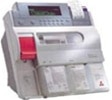Blood gas analyzers play an important role in clinical diagnostics, especially in critical or intensive care units. Since determining the status of blood gas is quite important for critically ill patients, it is crucial for healthcare facilities and clinical labs to use reliable and advanced analyzers that can streamline work processes and deliver accurate test results. A new report by Technavio provides an insight into the global blood gas analyzers market and details some of the emerging trends that are expected to impact the market outlook from 2017-2021.
The study report provides a detailed analysis on the global blood gas analyzers market for 2017-2021 based on the product type (portable and bench-top) and geography (the Americas, EMEA, and APAC). The increased shift towards point of care (POC) testing resulted in upgradations towards portable or bench-top models. With several advantages such as easy usage, less space, simpler sample collection and pre-analytical process, the adoption of these portable models will continue to increase in the coming years, especially in hospitals.
Geographically, the U.S. accounted for the highest pharmaceutical market share in 2016, which can be attributed to the increased research and development activity to discover new diagnostic procedures using blood gas analyzers and other instruments. Reports suggest that the market in the Americas is expected to reach $301.74 million by 2021. Several other countries like Brazil, Canada, and Mexico are witnessing an improvement in their healthcare infrastructure and this in turn is expected to boost the adoption of advanced diagnostic instruments.
It is estimated that the global blood gas analyzers market will grow to USD 672.75 million by 2021, at a CAGR of more than 6% over the forecast period. As per the report, the increasing prevalence of illness that can be analyzed through blood samples may influence the demand for blood gas analyzers in the coming years. In addition, the growing demand for personalized medicines is as one of the key factors identified for this market growth till 2021. The demand for personalized medicine is expected to grow at approximately 11.4% CAGR.
The report classifies the three major emerging trends associated with this market growth -
- Improvement in the healthcare industry - The development of innovative technology is crucial in the healthcare domain, as it provides a real-time diagnosis of the disease accelerating the patient's treatment process and reducing the number of cases of sudden death. The development of innovative diagnostic instruments like blood gas analyzers provide convenient, accurate and precise clinical test results like Point-of-care analyzers (POC) help clinicians assess patient status in real-time, resulting in faster therapeutic decisions. Time is a vital factor in blood gas analysis. Faster results improve patient management and treatment outcomes, reduce length of stay in expensive critical care units, and reduce medication costs.
- Ease of use and better awareness - In the past, blood measurements were difficult because of the large blood volume samples required. Modern blood gas analyzers adapt to both syringe and capillary samples and provide authentic estimations of corrosive base and ventilation status of the patient and offers fast, compact blood gas investigation for the purpose of need. The more established frameworks were open analyzers that allowed the healthcare centers to investigate distinct options for the OEMs for obtaining the consumables expected to run the instruments like anodes, reagents, and quality controls (QC). High sample integrity, user convenience and user safety, low documentation errors, short turnaround of time and reduced sample per cost make blood gas analyzers a significant apparatus for overseeing patient oxygenation and ventilation in different clinical settings.
- Adoption of standardization and automation across the in-vitro diagnostics industry - Cost-cutting in clinical labs has led to reduced profit margins, giving rise to a volume-based business model. The demand for error free results led clinical labs to adopt automated systems to improve workflow. In the US, laboratories take up automation due to the heavy influx of patients with insurance coverage.
Blood gas analyzers measure the concentration of hydrogen ions that are useful for measuring the amount of acidity and the levels of oxygen and carbon dioxide in the blood. Advanced analyzers have computer interfaces and internal algorithms to calculate pertinent parameters. Significant innovations in the blood gas analyzer technology ensure accurate and fast test results, resulting in the rapid adoption of these devices in various diagnostic centers. Innovative blood gas analyzer technologies have enhanced the analytical and clinical performance characteristics of many blood assays.



